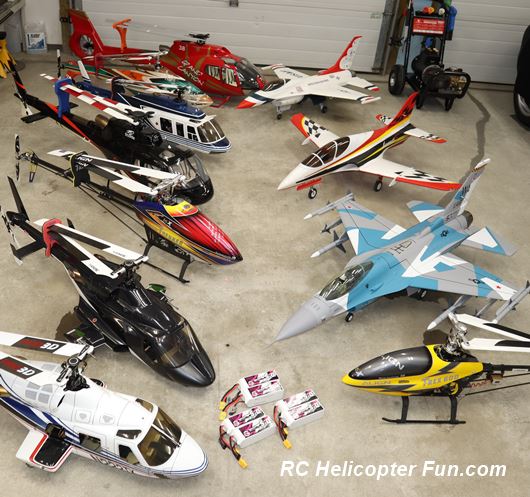Tail Belt Static
by David E. Buxton Feb 27, 2015
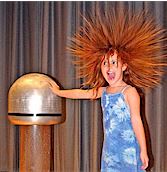
Tail belt static is a problem on many of our RC helicopters that use a tail belt drive system. These tail drive systems function much like a high voltage Van de Graff generator which also uses end pulleys and a belt.
Triboelectric tables predict how much static will be generated, depending on the two materials involved.
Based on the following list (derived from the above mentioned table), we could make the belt out of nylon and the pulleys out of vinyl.
The nylon belt would pick up a positive charge and the pulleys would take on a negative charge. This would be a very bad choice of materials for a helicopter.
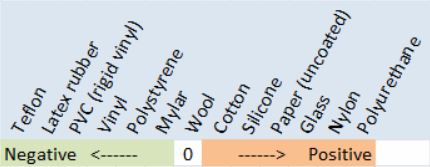 TriboElectric Table
TriboElectric TableTail Belt Static
A helicopter’s metal or carbon fiber tail boom is where the static builds up, much as it does on the dome of a Van de Graff generator.

Most RC pilots with belt drive tail helis don’t experience static electricity problems, even though they have not applied any of the treatments discussed in this article.
Adequate humidity is one explanation. Also consider that if the belt materials and pulleys are carefully selected to be close together on the TriboElectric table, then a minimal amount of tail belt static will build up.
Search the Internet for articles on what to do if your Van de Graff generator quits working and you will find that these generators can be defeated rather easily, e.g. oily dirt on the belt, lint and pointy bits of wire on the dome, humidity.
Nitro heli exhaust will oil the belt which is a good thing (why we rarely heard of tail belt static issues in the good old nitro only days).
Another explanation for why so few pilots encounter static problems is that too many pilots blame the manufacturer.
Some have dumped their Futaba radio systems and bought Spektrum or JR. Some have dumped their Spektrum systems and bought Futaba or who knows what it is they bought instead. Same goes for putting the blame on the specific flybarless system. Throwing all of brand X into the garbage is how they prefer to solve such problems.
Torque Tube
A torque tube generates considerably less static than a dry tail belt system and is more efficient for increased flight time.
Many of our helicopters use a torque tube which can be annoyingly fragile for beginners and for those who all too often land their helicopters on rough terrain, thick grass and weeds. A belt system is mechanically more robust and may be your best choice as long as static electricity problems can be eliminated.
In a dust storm, full scale helicopters generate spectacular amounts of static off their main rotors and tail blades. Spinning tail blades do generate static even if dust is not blowing. Gears, including main gear against pinion and torque tube gears do generate some static. A torque tube does not entirely eliminate helicopter static, especially when the air is unusually dry. A torque tube also contributes more vibration which can affect gyro performance.
Static Symptoms
Radio restarts (e.g. due to the radio’s power supply spiking too low) tend to result in the receiver ignoring the transmitter until the restart has completed. Static electricity tends to cause abrupt surprise behaviors and servo twitching. Tail Belt Static problems can also cause flybarless system restarts. In the Vbar data log, low voltage warnings are due to power supply problems and warm restarts are due to static hits. Your FBL system may log such problems somewhat differently.
You might want to read the Digital Servo Experiment and Receiver Power Supply articles as the restarts could be caused by digital servo related power supply problems. Worth reading if you are having digital servo related power supply problems.
More Physics
The physics of a Van de Graff style high voltage generator acts like a constant current source. A steady current flow into a capacitor (e.g. the Van de Graff dome, tail boom) results in the voltage steadily ramping up. The most common limits to increasing voltage are sparks, corona discharge and dissipative leakage paths (e.g. humid air, static dissipative products). Electronically noisy sparks and corona are what put your electronics at risk.
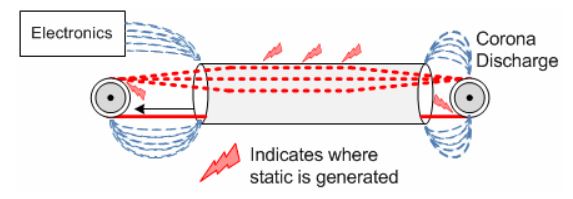
The lightning bolts shown in the diagram above indicate where the static electric currents are generated, rather than radiated. The blue lines indicate where corona discharge generally takes place.
Voltage Test Probe
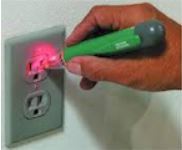
You can use a non-contact voltage tester which will light up when it detects a buildup of static electricity.
Try using the tester before and after you apply your remedies. You can use the tester to see how much progress you have made with your treatments.
Slack Tail Belt
The tail rotor puts a lot of load on the belt which causes it to stretch. The opposite side of the belt goes slack and slaps against the inside of the tail boom. This will especially be a problem when performing aggressive pirouette maneuvers.
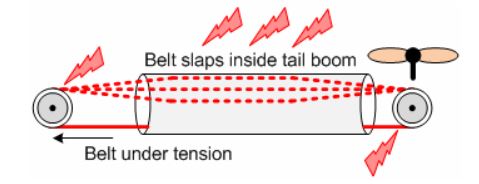
T-Rex 500
When first introduced, the T-Rex 500 quickly became infamous for crashing helicopters because the tail boom diameter was too small for the belt and pulley system. The belt slapping inside the tail boom was building up a lot of static on the tube. The resulting sparks and corona discharge was causing T-Rex 500s to perform very erratically and all too often smashing violently into the ground.
Align quickly responded by introducing a torque tube upgrade. They also changed the recipe for the belts in order to reduce static build up. There was a lot of discussion on the forums about how to deal with T-Rex 500 tail belt static. T-Rex 500 pilots more recently have been reporting that their belt drive heli flies just fine without any special treatment.
Static Suppression Methods
Greasy Tail Drive Belt
The most important thing that heli pilots can do is to keep the tail belt well lubricated which does an excellent job of nulling out the TriboElectric effect. Grease against grease has no TriboElectric difference. Lubricate all four surfaces of the belt. Experiments indicate that a good lubricant is more effective than graphite products selected for conductivity.
Another benefit of a lubricated belt is that it lasts forever, compared to a dry belt. E.g. a dry belt will try to climb the side walls of the pulley which results in most of the wear and tear, often resulting in loose strands of belt material. Use a dry silicon lubricant if you fly where dust is a problem or you don’t like cleaning up the grease that gets thrown off the belt. Reapply once in a while. Lubricating the gears is also recommended for reduced static noise, quieter performance and extended life.
Note that some lubricants (e.g. WD-40) are reported to be hostile to belt and pulley materials. Petroleum distillates are a problem. Properly select the lubricant (silicone based ones are best) and be aware that propellants can be a problem.
Heli Ground -- Tie It All Together
The following diagram illustrates where the TriboElectric effect generates static if the two separating surfaces are not lubricated. A carbon fiber frame will accomplish most of the illustrated connectivity without the need for wires.
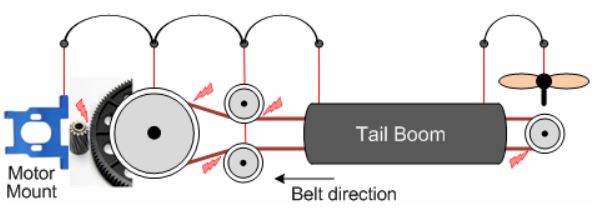
The most important connection is between the tail boom and the frame (tail booms are typically clamped in plastic). It is almost as important to connect the metal components of the tail assembly to the tail boom (a metal tail case would be an ideal solution). You can daisy chain the wiring as there is no need for a single point approach.
Dissipative or conductive interconnecting of all the conductive parts is recommended even if your heli uses a torque tube. Static can be effectively dissipated with 10 million Ohms, even as much as 100 million Ohms (e.g. humidity, static dissipative products). No need to sand off any paint unless you plan to use a multi meter to check wiring continuity.
If you have lubricated the belt and established a good heli ground system, then you may not need to apply any more treatments. If your heli flies in very dry air or you want minimal corona noise for better long range performance or you simply want to do what is best for your helicopter’s FBL and radio system, then the following will be of interest to you.
Static Dissipation Products
There are several static dissipation products available. The most commonly available is Static Guard which is marketed for household use. I asked about using it on our helicopters and here is their reply:
"As noted on our website, we do recommend using it on children's plastic toy sets and plastic lawn furniture. Static Guard should be sprayed onto a cloth then wiped onto the furniture. We don't recommend spraying directly onto the plastic and a small test spot should always be done. The product has not been tested on model helicopter plastics and so we are unsure if it will damage them."
Note the caution regarding the propellant, which is something to be concerned about with any sprayed on product, e.g. silicon spray. Personally, I have encountered no problems with directly spraying helicopter gears and pulleys with Static Guard. There is no reason to spray the tail belt with Static Guard and so it is best not to do so. The belt needs a lubricant, not a dissipative treatment.
The plastic belt pulleys near or on the main shaft are a bit of a challenge if there is static to be removed there. Applying a static dissipative product to these gears and pulleys is an effective treatment when the metal shafts are tied into the heli ground system.
Static Wick
High voltages emit most aggressively from sharp edges and especially sharp points, which is why lightning rods are sharpened. A few thin wires pointed outward on a Van de Graff generator’s dome will dramatically reduce how far the sparks can zap out at you. A “static wick” can be devised using a length of highly flexible old LiPo battery cable. Melt a bit of solder into the end that will be mounted and fan out the multitude of thin sharp wires at the other end. Static wicks are commercially available.
Does your heli need any static wicks? If you have lubricated the belt and implemented an effective heli ground system, then there will be very little static remaining for a static wick to be of much value. If plastic gears and/or pulleys are causing a problem and you don’t want to apply a dissipative product, then static wicks would be an alternative worth considering.
High Voltage Power Line Example
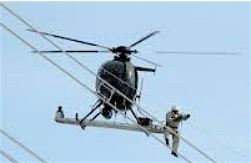
Many of you have seen videos of high voltage power line technicians working from helicopters. They must electrically clamp onto the cable before they can put their hands on the high voltage.
They are safe as long as the technician’s body voltage rides up and down at 50 or 60 Hz with the very high cable voltage.
Some references say that static electric corona frequencies are 10 kHz to 100 kHz, that most of the energy is between 20 and 40 kHz, some of it reaches as high as 1 Mhz and higher if voltages get really way up there. Corona discharge frequencies are very low relative to our 2.4 GHz radio frequencies, so the high voltage power line technician analogy applies. It does make sense to connect radio ground to heli ground.
Your 2.4 GHz radio can easily ignore corona frequencies. The problem is with the potentially high energy densities that can couple into the non RF sections of the radio and servos.
Connecting Radio Ground to Heli Ground
I have discussed the problem of connecting heli ground to radio ground with several electronics engineers, e.g. an engineer who designs high voltage probes for oscilloscopes. Electronics engineers frequently deal with analog ground which must be kept quiet that must connect with very noisy digital &/or high voltage circuits. After talking about heli ground and radio ground I posed the following question:
Imagine a Van de Graff machine and a radio nearby on an insulated stand. What would you do for best radio performance? The answer is to directly connect a wire between the dome and the radio’s ground. This solution is recommended because the corona frequencies are well below 2.4 GHz. For helicopters, if we are concerned about high fault currents from the battery or a defective motor, then use a resistor in parallel with a capacitor. A resistor will limit the maximum fault current. The capacitor is intended to provide an effective short circuit at corona frequencies. As illustrated by the technician on the half megavolt power line, we want the radio system to dance up and down with the helicopter.
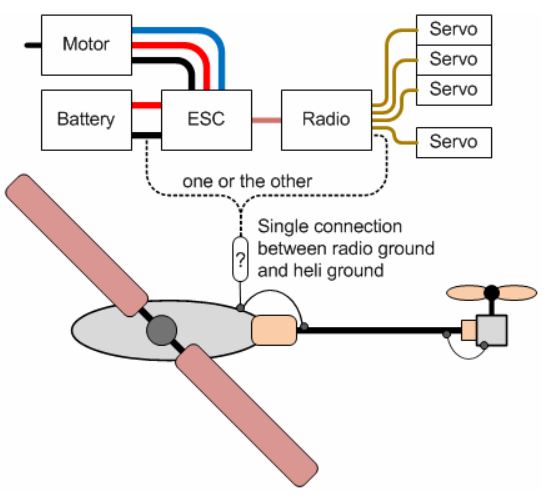
There are alternatives to using a resistor and capacitor in parallel when making the connection:
- My Mikado 550 has a plastic frame which is non conductive and provides excellent mechanical protection for the motor. I directly connected heli ground into a spare servo slot on my Vbar which uses Spektrum satellite antennas.
- Connecting to battery negative would be less of a risk.
- Use a two Amp fuse and check it occasionally to be sure it has not blown.
- Just use a resistor and skip the capacitor, better than no connection.
PolyFuse
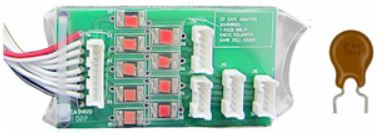
There are non-mechanical PolyFuses that normally operate at low resistance and become highly resistive when they heat up. They are used by LiPo battery charging systems designed for parallel charging. See illustration above. A PolyFuse would provide an excellent way to connect heli ground to radio ground.
Tail Belt Static Hits Can Be a Big Surprise
A stack up of problems can catch up with your helicopter. Perhaps it has been flying flawlessly for months, symptom free even though you have applied none of the treatments presented in this article. Then suddenly it exhibits some spontaneous, even violent behaviors, perhaps due to one or more servos twitching.
The buildup for a perfect storm could be due to unusually low humidity, belt lubrication has been fading, the belt has been aging and is a bit longer because of environmental changes, and then you were executing some aggressive sustained pirouette maneuvers. The big surprise was completely unexpected and without warning. Hopefully your heli did not smash into the ground.
Static Summary
The most important thing that you can do is to defeat the tail belt’s Van de Graff generator behavior by lubricating the belt.
This is intended to defeat the TriboElectric effect which determines how static charges get generated. It is also recommended that you develop a good heli ground system for your helicopter, even if it uses a torque tube. A non-contact voltage sensor can be used to evaluate how effective your treatments have been.
David is an electrical engineer at Tektronix. There he works with oscilloscopes, spectrum analyzers, logic analyzers, video monitors and generators.
Question/s for Dave? Feel free to use the contact form below...






